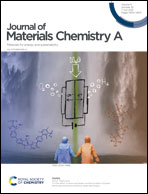Fluorination activates the basal plane HER activity of ReS2: a combined experimental and theoretical study†
Abstract
Two-dimensional (2D) rhenium disulfide (ReS2) has been attracting immense interest as a highly promising hydrogen evolution reaction (HER) electrocatalyst recently. However, the HER catalytic active sites of ReS2 are still limited to the finite edges of the nanosheets and the basal-plane is catalytically inert. How to activate the in-plane catalytic activity of ReS2 accordingly becomes the sticking point to further boost its H2 evolution efficiency. Here, the fluorinated ReS2 hierarchical structure assembled as ultrathin nanosheets is proved to exhibit excellent HER activity, where the optimal sample of ReS2-F5.93 shows a low overpotential of 142 mV vs. RHE at a current density of 10 mA cm−2, a Tafel slope of 64 mV dec−1, and significantly improved stability. The enhanced HER performance is mainly attributed to the synergistic effects of increased in-plane active sites and remarkably accelerated charge transfer kinetics. The density functional theory calculation results reveal that F doping can yield the optimal H* adsorption Gibbs free energy and meanwhile increase the electronic states near the Fermi level for accelerated electron transfer. This work can broaden the horizon for designing efficient HER electrocatalysts via activating the in-plane catalytic activity of transition metal dichalcogenides (TMDs).



 Please wait while we load your content...
Please wait while we load your content...